MBM Dissertation: Leadership Effectiveness in the NHS (Case Study)
VerifiedAdded on 2023/06/10
|9
|3547
|81
Project
AI Summary
This dissertation proposal examines leadership effectiveness within the National Health Service (NHS), specifically focusing on the Royal United Bath Hospital in the UK. The research aims to analyze various leadership theories and their practical application in the public sector, considering the NHS's organizational life cycle. The proposal outlines the project's background, rationale, and objectives, emphasizing the debate on whether leaders are born or made and the importance of adapting leadership styles to different organizational stages. It includes a literature review exploring key concepts like leadership effectiveness, public services, and different leadership theories (traits, style, and contingency). The proposal also highlights the importance of leadership in navigating challenges such as government funding cuts and potential privatization, and suggests how leaders can foster a culture of continuous improvement and employee engagement. The proposal concludes with a list of relevant sources, including books and journal articles, that will inform the research and analysis. This research is crucial for understanding how effective leadership can improve the management of employees and the provision of health and well-being services.
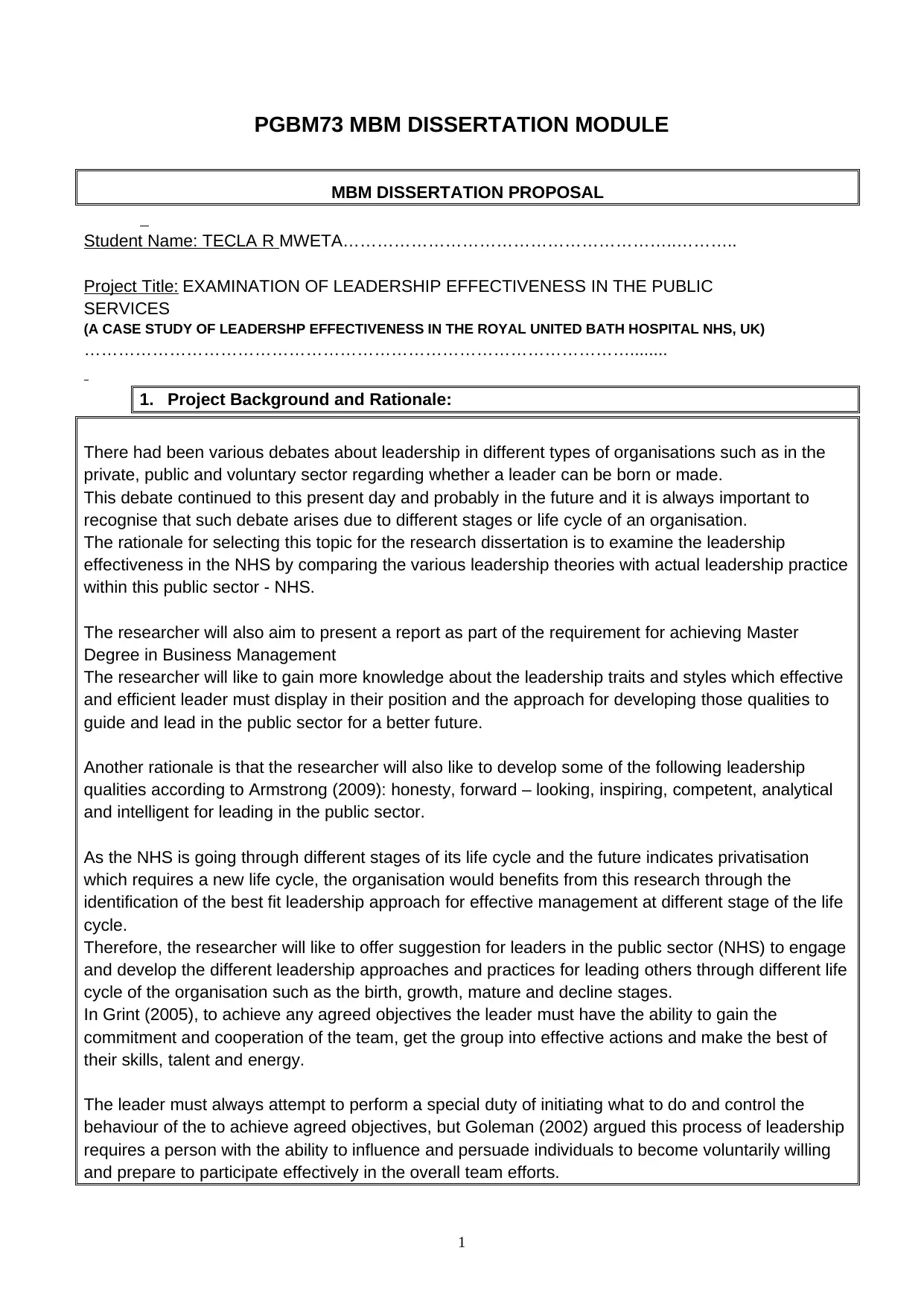
PGBM73 MBM DISSERTATION MODULE
MBM DISSERTATION PROPOSAL
Student Name: TECLA R MWETA…………………………………………………..………..
Project Title: EXAMINATION OF LEADERSHIP EFFECTIVENESS IN THE PUBLIC
SERVICES
(A CASE STUDY OF LEADERSHP EFFECTIVENESS IN THE ROYAL UNITED BATH HOSPITAL NHS, UK)
……………………………………………………………………………………........
1. Project Background and Rationale:
There had been various debates about leadership in different types of organisations such as in the
private, public and voluntary sector regarding whether a leader can be born or made.
This debate continued to this present day and probably in the future and it is always important to
recognise that such debate arises due to different stages or life cycle of an organisation.
The rationale for selecting this topic for the research dissertation is to examine the leadership
effectiveness in the NHS by comparing the various leadership theories with actual leadership practice
within this public sector - NHS.
The researcher will also aim to present a report as part of the requirement for achieving Master
Degree in Business Management
The researcher will like to gain more knowledge about the leadership traits and styles which effective
and efficient leader must display in their position and the approach for developing those qualities to
guide and lead in the public sector for a better future.
Another rationale is that the researcher will also like to develop some of the following leadership
qualities according to Armstrong (2009): honesty, forward – looking, inspiring, competent, analytical
and intelligent for leading in the public sector.
As the NHS is going through different stages of its life cycle and the future indicates privatisation
which requires a new life cycle, the organisation would benefits from this research through the
identification of the best fit leadership approach for effective management at different stage of the life
cycle.
Therefore, the researcher will like to offer suggestion for leaders in the public sector (NHS) to engage
and develop the different leadership approaches and practices for leading others through different life
cycle of the organisation such as the birth, growth, mature and decline stages.
In Grint (2005), to achieve any agreed objectives the leader must have the ability to gain the
commitment and cooperation of the team, get the group into effective actions and make the best of
their skills, talent and energy.
The leader must always attempt to perform a special duty of initiating what to do and control the
behaviour of the to achieve agreed objectives, but Goleman (2002) argued this process of leadership
requires a person with the ability to influence and persuade individuals to become voluntarily willing
and prepare to participate effectively in the overall team efforts.
1
MBM DISSERTATION PROPOSAL
Student Name: TECLA R MWETA…………………………………………………..………..
Project Title: EXAMINATION OF LEADERSHIP EFFECTIVENESS IN THE PUBLIC
SERVICES
(A CASE STUDY OF LEADERSHP EFFECTIVENESS IN THE ROYAL UNITED BATH HOSPITAL NHS, UK)
……………………………………………………………………………………........
1. Project Background and Rationale:
There had been various debates about leadership in different types of organisations such as in the
private, public and voluntary sector regarding whether a leader can be born or made.
This debate continued to this present day and probably in the future and it is always important to
recognise that such debate arises due to different stages or life cycle of an organisation.
The rationale for selecting this topic for the research dissertation is to examine the leadership
effectiveness in the NHS by comparing the various leadership theories with actual leadership practice
within this public sector - NHS.
The researcher will also aim to present a report as part of the requirement for achieving Master
Degree in Business Management
The researcher will like to gain more knowledge about the leadership traits and styles which effective
and efficient leader must display in their position and the approach for developing those qualities to
guide and lead in the public sector for a better future.
Another rationale is that the researcher will also like to develop some of the following leadership
qualities according to Armstrong (2009): honesty, forward – looking, inspiring, competent, analytical
and intelligent for leading in the public sector.
As the NHS is going through different stages of its life cycle and the future indicates privatisation
which requires a new life cycle, the organisation would benefits from this research through the
identification of the best fit leadership approach for effective management at different stage of the life
cycle.
Therefore, the researcher will like to offer suggestion for leaders in the public sector (NHS) to engage
and develop the different leadership approaches and practices for leading others through different life
cycle of the organisation such as the birth, growth, mature and decline stages.
In Grint (2005), to achieve any agreed objectives the leader must have the ability to gain the
commitment and cooperation of the team, get the group into effective actions and make the best of
their skills, talent and energy.
The leader must always attempt to perform a special duty of initiating what to do and control the
behaviour of the to achieve agreed objectives, but Goleman (2002) argued this process of leadership
requires a person with the ability to influence and persuade individuals to become voluntarily willing
and prepare to participate effectively in the overall team efforts.
1
Paraphrase This Document
Need a fresh take? Get an instant paraphrase of this document with our AI Paraphraser
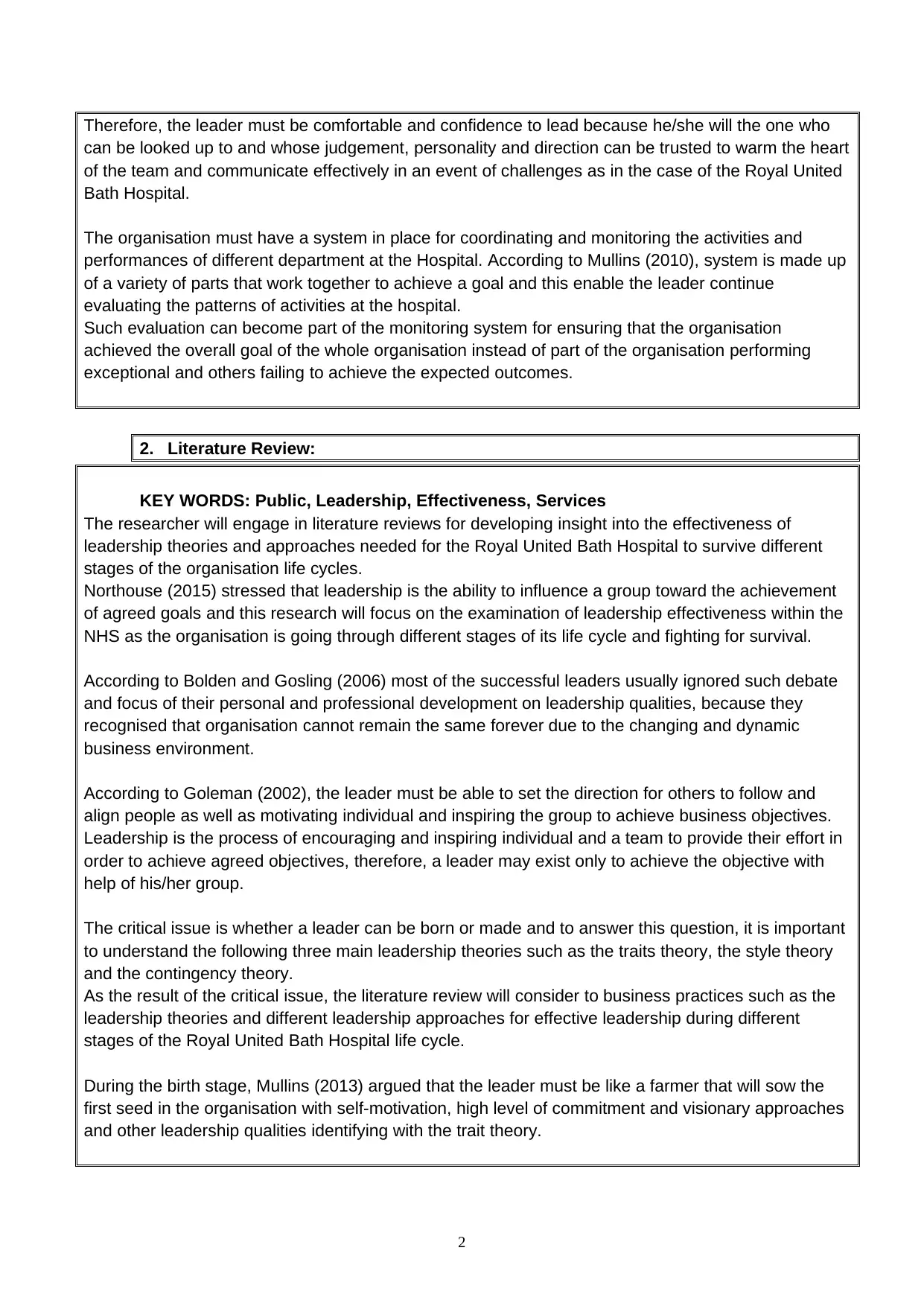
Therefore, the leader must be comfortable and confidence to lead because he/she will the one who
can be looked up to and whose judgement, personality and direction can be trusted to warm the heart
of the team and communicate effectively in an event of challenges as in the case of the Royal United
Bath Hospital.
The organisation must have a system in place for coordinating and monitoring the activities and
performances of different department at the Hospital. According to Mullins (2010), system is made up
of a variety of parts that work together to achieve a goal and this enable the leader continue
evaluating the patterns of activities at the hospital.
Such evaluation can become part of the monitoring system for ensuring that the organisation
achieved the overall goal of the whole organisation instead of part of the organisation performing
exceptional and others failing to achieve the expected outcomes.
2. Literature Review:
KEY WORDS: Public, Leadership, Effectiveness, Services
The researcher will engage in literature reviews for developing insight into the effectiveness of
leadership theories and approaches needed for the Royal United Bath Hospital to survive different
stages of the organisation life cycles.
Northouse (2015) stressed that leadership is the ability to influence a group toward the achievement
of agreed goals and this research will focus on the examination of leadership effectiveness within the
NHS as the organisation is going through different stages of its life cycle and fighting for survival.
According to Bolden and Gosling (2006) most of the successful leaders usually ignored such debate
and focus of their personal and professional development on leadership qualities, because they
recognised that organisation cannot remain the same forever due to the changing and dynamic
business environment.
According to Goleman (2002), the leader must be able to set the direction for others to follow and
align people as well as motivating individual and inspiring the group to achieve business objectives.
Leadership is the process of encouraging and inspiring individual and a team to provide their effort in
order to achieve agreed objectives, therefore, a leader may exist only to achieve the objective with
help of his/her group.
The critical issue is whether a leader can be born or made and to answer this question, it is important
to understand the following three main leadership theories such as the traits theory, the style theory
and the contingency theory.
As the result of the critical issue, the literature review will consider to business practices such as the
leadership theories and different leadership approaches for effective leadership during different
stages of the Royal United Bath Hospital life cycle.
During the birth stage, Mullins (2013) argued that the leader must be like a farmer that will sow the
first seed in the organisation with self-motivation, high level of commitment and visionary approaches
and other leadership qualities identifying with the trait theory.
2
can be looked up to and whose judgement, personality and direction can be trusted to warm the heart
of the team and communicate effectively in an event of challenges as in the case of the Royal United
Bath Hospital.
The organisation must have a system in place for coordinating and monitoring the activities and
performances of different department at the Hospital. According to Mullins (2010), system is made up
of a variety of parts that work together to achieve a goal and this enable the leader continue
evaluating the patterns of activities at the hospital.
Such evaluation can become part of the monitoring system for ensuring that the organisation
achieved the overall goal of the whole organisation instead of part of the organisation performing
exceptional and others failing to achieve the expected outcomes.
2. Literature Review:
KEY WORDS: Public, Leadership, Effectiveness, Services
The researcher will engage in literature reviews for developing insight into the effectiveness of
leadership theories and approaches needed for the Royal United Bath Hospital to survive different
stages of the organisation life cycles.
Northouse (2015) stressed that leadership is the ability to influence a group toward the achievement
of agreed goals and this research will focus on the examination of leadership effectiveness within the
NHS as the organisation is going through different stages of its life cycle and fighting for survival.
According to Bolden and Gosling (2006) most of the successful leaders usually ignored such debate
and focus of their personal and professional development on leadership qualities, because they
recognised that organisation cannot remain the same forever due to the changing and dynamic
business environment.
According to Goleman (2002), the leader must be able to set the direction for others to follow and
align people as well as motivating individual and inspiring the group to achieve business objectives.
Leadership is the process of encouraging and inspiring individual and a team to provide their effort in
order to achieve agreed objectives, therefore, a leader may exist only to achieve the objective with
help of his/her group.
The critical issue is whether a leader can be born or made and to answer this question, it is important
to understand the following three main leadership theories such as the traits theory, the style theory
and the contingency theory.
As the result of the critical issue, the literature review will consider to business practices such as the
leadership theories and different leadership approaches for effective leadership during different
stages of the Royal United Bath Hospital life cycle.
During the birth stage, Mullins (2013) argued that the leader must be like a farmer that will sow the
first seed in the organisation with self-motivation, high level of commitment and visionary approaches
and other leadership qualities identifying with the trait theory.
2
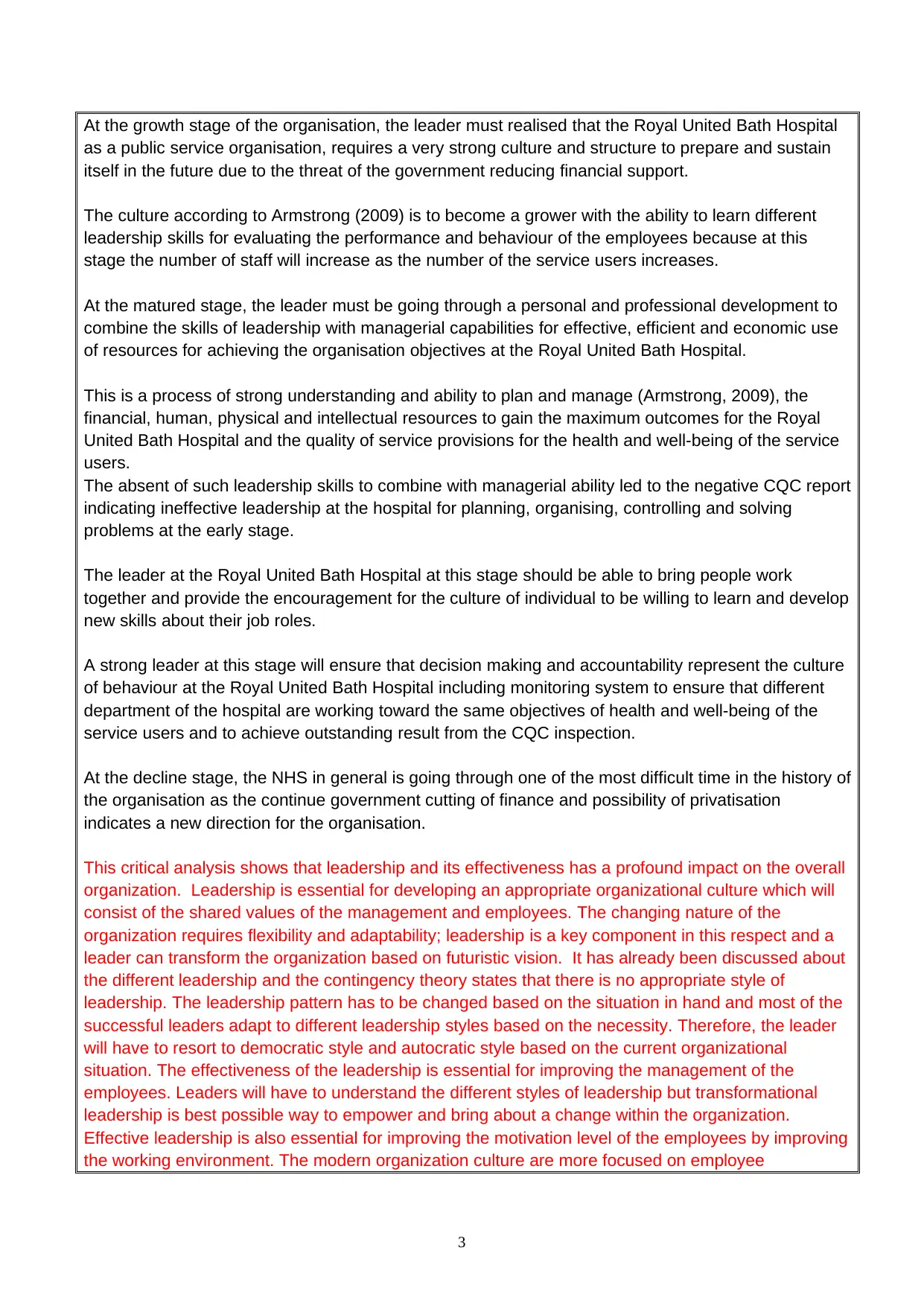
At the growth stage of the organisation, the leader must realised that the Royal United Bath Hospital
as a public service organisation, requires a very strong culture and structure to prepare and sustain
itself in the future due to the threat of the government reducing financial support.
The culture according to Armstrong (2009) is to become a grower with the ability to learn different
leadership skills for evaluating the performance and behaviour of the employees because at this
stage the number of staff will increase as the number of the service users increases.
At the matured stage, the leader must be going through a personal and professional development to
combine the skills of leadership with managerial capabilities for effective, efficient and economic use
of resources for achieving the organisation objectives at the Royal United Bath Hospital.
This is a process of strong understanding and ability to plan and manage (Armstrong, 2009), the
financial, human, physical and intellectual resources to gain the maximum outcomes for the Royal
United Bath Hospital and the quality of service provisions for the health and well-being of the service
users.
The absent of such leadership skills to combine with managerial ability led to the negative CQC report
indicating ineffective leadership at the hospital for planning, organising, controlling and solving
problems at the early stage.
The leader at the Royal United Bath Hospital at this stage should be able to bring people work
together and provide the encouragement for the culture of individual to be willing to learn and develop
new skills about their job roles.
A strong leader at this stage will ensure that decision making and accountability represent the culture
of behaviour at the Royal United Bath Hospital including monitoring system to ensure that different
department of the hospital are working toward the same objectives of health and well-being of the
service users and to achieve outstanding result from the CQC inspection.
At the decline stage, the NHS in general is going through one of the most difficult time in the history of
the organisation as the continue government cutting of finance and possibility of privatisation
indicates a new direction for the organisation.
This critical analysis shows that leadership and its effectiveness has a profound impact on the overall
organization. Leadership is essential for developing an appropriate organizational culture which will
consist of the shared values of the management and employees. The changing nature of the
organization requires flexibility and adaptability; leadership is a key component in this respect and a
leader can transform the organization based on futuristic vision. It has already been discussed about
the different leadership and the contingency theory states that there is no appropriate style of
leadership. The leadership pattern has to be changed based on the situation in hand and most of the
successful leaders adapt to different leadership styles based on the necessity. Therefore, the leader
will have to resort to democratic style and autocratic style based on the current organizational
situation. The effectiveness of the leadership is essential for improving the management of the
employees. Leaders will have to understand the different styles of leadership but transformational
leadership is best possible way to empower and bring about a change within the organization.
Effective leadership is also essential for improving the motivation level of the employees by improving
the working environment. The modern organization culture are more focused on employee
3
as a public service organisation, requires a very strong culture and structure to prepare and sustain
itself in the future due to the threat of the government reducing financial support.
The culture according to Armstrong (2009) is to become a grower with the ability to learn different
leadership skills for evaluating the performance and behaviour of the employees because at this
stage the number of staff will increase as the number of the service users increases.
At the matured stage, the leader must be going through a personal and professional development to
combine the skills of leadership with managerial capabilities for effective, efficient and economic use
of resources for achieving the organisation objectives at the Royal United Bath Hospital.
This is a process of strong understanding and ability to plan and manage (Armstrong, 2009), the
financial, human, physical and intellectual resources to gain the maximum outcomes for the Royal
United Bath Hospital and the quality of service provisions for the health and well-being of the service
users.
The absent of such leadership skills to combine with managerial ability led to the negative CQC report
indicating ineffective leadership at the hospital for planning, organising, controlling and solving
problems at the early stage.
The leader at the Royal United Bath Hospital at this stage should be able to bring people work
together and provide the encouragement for the culture of individual to be willing to learn and develop
new skills about their job roles.
A strong leader at this stage will ensure that decision making and accountability represent the culture
of behaviour at the Royal United Bath Hospital including monitoring system to ensure that different
department of the hospital are working toward the same objectives of health and well-being of the
service users and to achieve outstanding result from the CQC inspection.
At the decline stage, the NHS in general is going through one of the most difficult time in the history of
the organisation as the continue government cutting of finance and possibility of privatisation
indicates a new direction for the organisation.
This critical analysis shows that leadership and its effectiveness has a profound impact on the overall
organization. Leadership is essential for developing an appropriate organizational culture which will
consist of the shared values of the management and employees. The changing nature of the
organization requires flexibility and adaptability; leadership is a key component in this respect and a
leader can transform the organization based on futuristic vision. It has already been discussed about
the different leadership and the contingency theory states that there is no appropriate style of
leadership. The leadership pattern has to be changed based on the situation in hand and most of the
successful leaders adapt to different leadership styles based on the necessity. Therefore, the leader
will have to resort to democratic style and autocratic style based on the current organizational
situation. The effectiveness of the leadership is essential for improving the management of the
employees. Leaders will have to understand the different styles of leadership but transformational
leadership is best possible way to empower and bring about a change within the organization.
Effective leadership is also essential for improving the motivation level of the employees by improving
the working environment. The modern organization culture are more focused on employee
3
⊘ This is a preview!⊘
Do you want full access?
Subscribe today to unlock all pages.

Trusted by 1+ million students worldwide
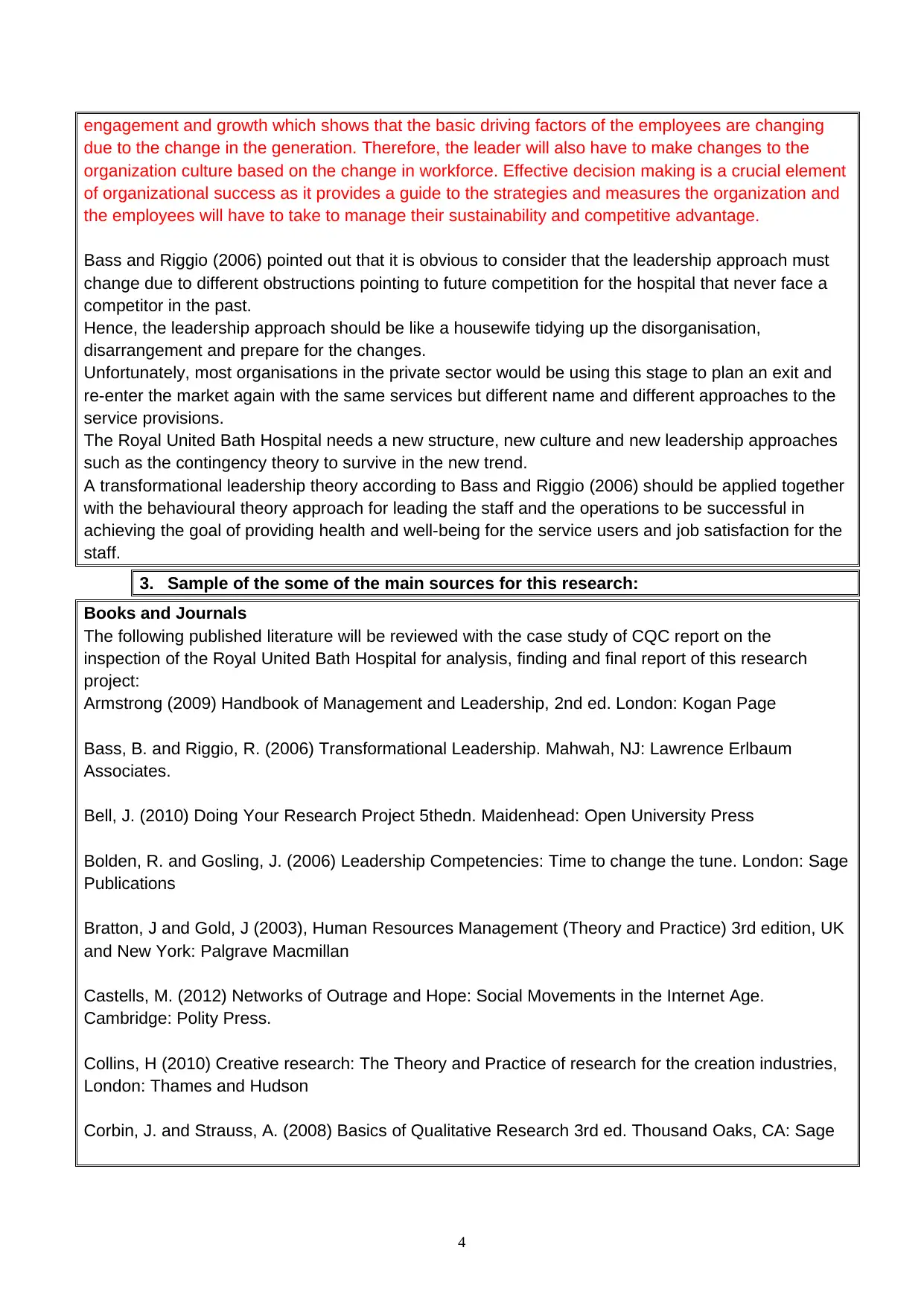
engagement and growth which shows that the basic driving factors of the employees are changing
due to the change in the generation. Therefore, the leader will also have to make changes to the
organization culture based on the change in workforce. Effective decision making is a crucial element
of organizational success as it provides a guide to the strategies and measures the organization and
the employees will have to take to manage their sustainability and competitive advantage.
Bass and Riggio (2006) pointed out that it is obvious to consider that the leadership approach must
change due to different obstructions pointing to future competition for the hospital that never face a
competitor in the past.
Hence, the leadership approach should be like a housewife tidying up the disorganisation,
disarrangement and prepare for the changes.
Unfortunately, most organisations in the private sector would be using this stage to plan an exit and
re-enter the market again with the same services but different name and different approaches to the
service provisions.
The Royal United Bath Hospital needs a new structure, new culture and new leadership approaches
such as the contingency theory to survive in the new trend.
A transformational leadership theory according to Bass and Riggio (2006) should be applied together
with the behavioural theory approach for leading the staff and the operations to be successful in
achieving the goal of providing health and well-being for the service users and job satisfaction for the
staff.
3. Sample of the some of the main sources for this research:
Books and Journals
The following published literature will be reviewed with the case study of CQC report on the
inspection of the Royal United Bath Hospital for analysis, finding and final report of this research
project:
Armstrong (2009) Handbook of Management and Leadership, 2nd ed. London: Kogan Page
Bass, B. and Riggio, R. (2006) Transformational Leadership. Mahwah, NJ: Lawrence Erlbaum
Associates.
Bell, J. (2010) Doing Your Research Project 5thedn. Maidenhead: Open University Press
Bolden, R. and Gosling, J. (2006) Leadership Competencies: Time to change the tune. London: Sage
Publications
Bratton, J and Gold, J (2003), Human Resources Management (Theory and Practice) 3rd edition, UK
and New York: Palgrave Macmillan
Castells, M. (2012) Networks of Outrage and Hope: Social Movements in the Internet Age.
Cambridge: Polity Press.
Collins, H (2010) Creative research: The Theory and Practice of research for the creation industries,
London: Thames and Hudson
Corbin, J. and Strauss, A. (2008) Basics of Qualitative Research 3rd ed. Thousand Oaks, CA: Sage
4
due to the change in the generation. Therefore, the leader will also have to make changes to the
organization culture based on the change in workforce. Effective decision making is a crucial element
of organizational success as it provides a guide to the strategies and measures the organization and
the employees will have to take to manage their sustainability and competitive advantage.
Bass and Riggio (2006) pointed out that it is obvious to consider that the leadership approach must
change due to different obstructions pointing to future competition for the hospital that never face a
competitor in the past.
Hence, the leadership approach should be like a housewife tidying up the disorganisation,
disarrangement and prepare for the changes.
Unfortunately, most organisations in the private sector would be using this stage to plan an exit and
re-enter the market again with the same services but different name and different approaches to the
service provisions.
The Royal United Bath Hospital needs a new structure, new culture and new leadership approaches
such as the contingency theory to survive in the new trend.
A transformational leadership theory according to Bass and Riggio (2006) should be applied together
with the behavioural theory approach for leading the staff and the operations to be successful in
achieving the goal of providing health and well-being for the service users and job satisfaction for the
staff.
3. Sample of the some of the main sources for this research:
Books and Journals
The following published literature will be reviewed with the case study of CQC report on the
inspection of the Royal United Bath Hospital for analysis, finding and final report of this research
project:
Armstrong (2009) Handbook of Management and Leadership, 2nd ed. London: Kogan Page
Bass, B. and Riggio, R. (2006) Transformational Leadership. Mahwah, NJ: Lawrence Erlbaum
Associates.
Bell, J. (2010) Doing Your Research Project 5thedn. Maidenhead: Open University Press
Bolden, R. and Gosling, J. (2006) Leadership Competencies: Time to change the tune. London: Sage
Publications
Bratton, J and Gold, J (2003), Human Resources Management (Theory and Practice) 3rd edition, UK
and New York: Palgrave Macmillan
Castells, M. (2012) Networks of Outrage and Hope: Social Movements in the Internet Age.
Cambridge: Polity Press.
Collins, H (2010) Creative research: The Theory and Practice of research for the creation industries,
London: Thames and Hudson
Corbin, J. and Strauss, A. (2008) Basics of Qualitative Research 3rd ed. Thousand Oaks, CA: Sage
4
Paraphrase This Document
Need a fresh take? Get an instant paraphrase of this document with our AI Paraphraser
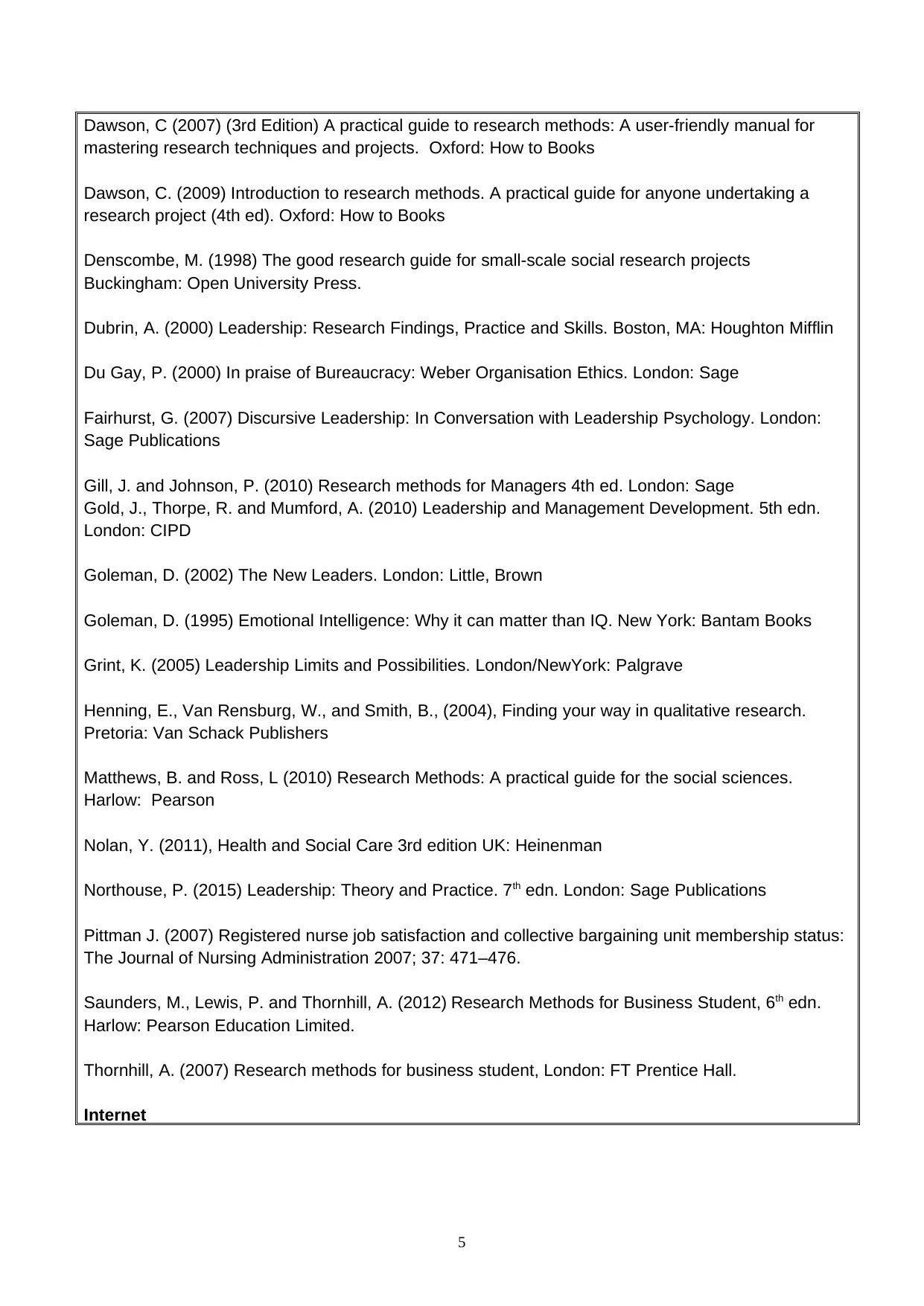
Dawson, C (2007) (3rd Edition) A practical guide to research methods: A user-friendly manual for
mastering research techniques and projects. Oxford: How to Books
Dawson, C. (2009) Introduction to research methods. A practical guide for anyone undertaking a
research project (4th ed). Oxford: How to Books
Denscombe, M. (1998) The good research guide for small-scale social research projects
Buckingham: Open University Press.
Dubrin, A. (2000) Leadership: Research Findings, Practice and Skills. Boston, MA: Houghton Mifflin
Du Gay, P. (2000) In praise of Bureaucracy: Weber Organisation Ethics. London: Sage
Fairhurst, G. (2007) Discursive Leadership: In Conversation with Leadership Psychology. London:
Sage Publications
Gill, J. and Johnson, P. (2010) Research methods for Managers 4th ed. London: Sage
Gold, J., Thorpe, R. and Mumford, A. (2010) Leadership and Management Development. 5th edn.
London: CIPD
Goleman, D. (2002) The New Leaders. London: Little, Brown
Goleman, D. (1995) Emotional Intelligence: Why it can matter than IQ. New York: Bantam Books
Grint, K. (2005) Leadership Limits and Possibilities. London/NewYork: Palgrave
Henning, E., Van Rensburg, W., and Smith, B., (2004), Finding your way in qualitative research.
Pretoria: Van Schack Publishers
Matthews, B. and Ross, L (2010) Research Methods: A practical guide for the social sciences.
Harlow: Pearson
Nolan, Y. (2011), Health and Social Care 3rd edition UK: Heinenman
Northouse, P. (2015) Leadership: Theory and Practice. 7th edn. London: Sage Publications
Pittman J. (2007) Registered nurse job satisfaction and collective bargaining unit membership status:
The Journal of Nursing Administration 2007; 37: 471–476.
Saunders, M., Lewis, P. and Thornhill, A. (2012) Research Methods for Business Student, 6th edn.
Harlow: Pearson Education Limited.
Thornhill, A. (2007) Research methods for business student, London: FT Prentice Hall.
Internet
5
mastering research techniques and projects. Oxford: How to Books
Dawson, C. (2009) Introduction to research methods. A practical guide for anyone undertaking a
research project (4th ed). Oxford: How to Books
Denscombe, M. (1998) The good research guide for small-scale social research projects
Buckingham: Open University Press.
Dubrin, A. (2000) Leadership: Research Findings, Practice and Skills. Boston, MA: Houghton Mifflin
Du Gay, P. (2000) In praise of Bureaucracy: Weber Organisation Ethics. London: Sage
Fairhurst, G. (2007) Discursive Leadership: In Conversation with Leadership Psychology. London:
Sage Publications
Gill, J. and Johnson, P. (2010) Research methods for Managers 4th ed. London: Sage
Gold, J., Thorpe, R. and Mumford, A. (2010) Leadership and Management Development. 5th edn.
London: CIPD
Goleman, D. (2002) The New Leaders. London: Little, Brown
Goleman, D. (1995) Emotional Intelligence: Why it can matter than IQ. New York: Bantam Books
Grint, K. (2005) Leadership Limits and Possibilities. London/NewYork: Palgrave
Henning, E., Van Rensburg, W., and Smith, B., (2004), Finding your way in qualitative research.
Pretoria: Van Schack Publishers
Matthews, B. and Ross, L (2010) Research Methods: A practical guide for the social sciences.
Harlow: Pearson
Nolan, Y. (2011), Health and Social Care 3rd edition UK: Heinenman
Northouse, P. (2015) Leadership: Theory and Practice. 7th edn. London: Sage Publications
Pittman J. (2007) Registered nurse job satisfaction and collective bargaining unit membership status:
The Journal of Nursing Administration 2007; 37: 471–476.
Saunders, M., Lewis, P. and Thornhill, A. (2012) Research Methods for Business Student, 6th edn.
Harlow: Pearson Education Limited.
Thornhill, A. (2007) Research methods for business student, London: FT Prentice Hall.
Internet
5
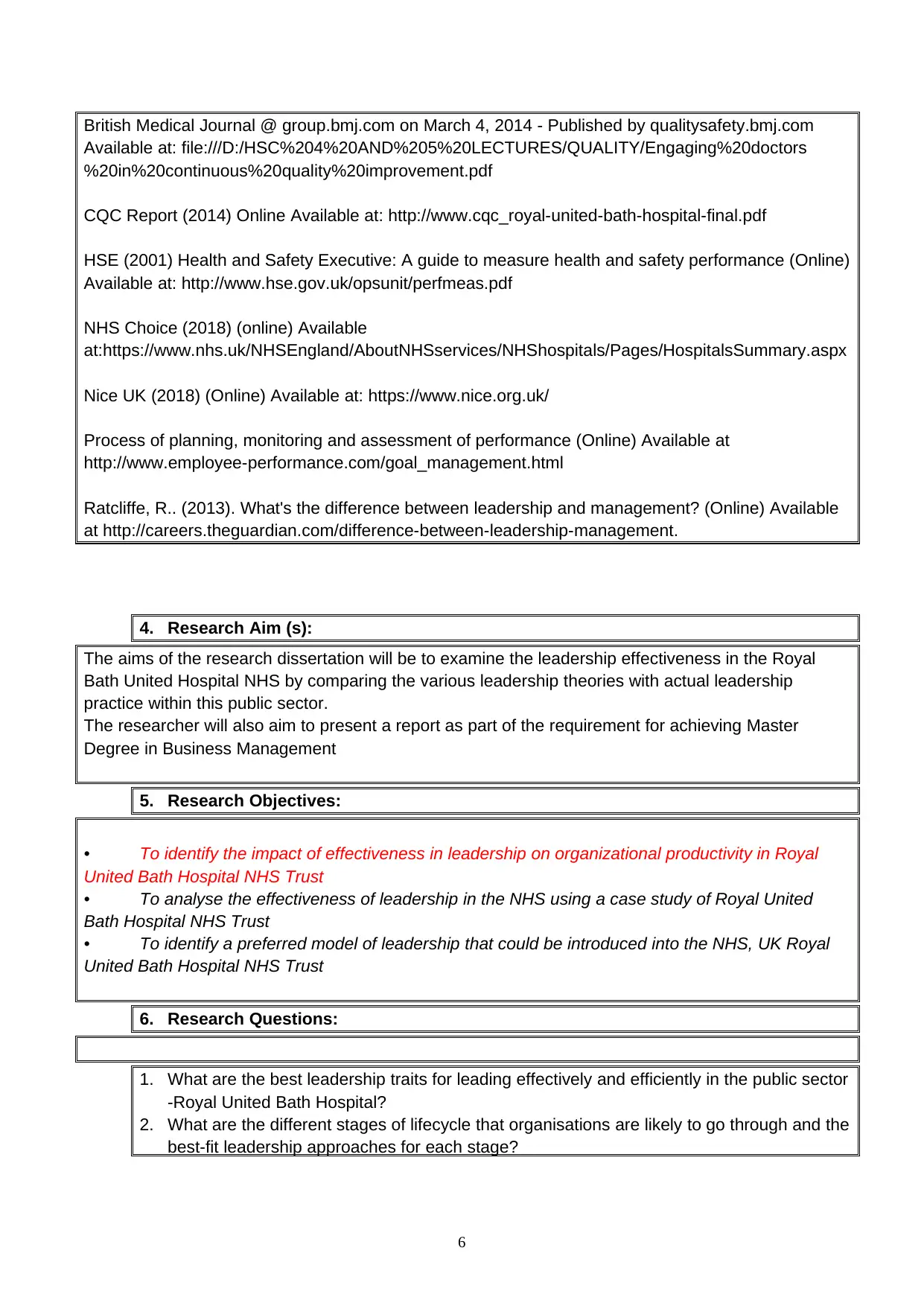
British Medical Journal @ group.bmj.com on March 4, 2014 - Published by qualitysafety.bmj.com
Available at: file:///D:/HSC%204%20AND%205%20LECTURES/QUALITY/Engaging%20doctors
%20in%20continuous%20quality%20improvement.pdf
CQC Report (2014) Online Available at: http://www.cqc_royal-united-bath-hospital-final.pdf
HSE (2001) Health and Safety Executive: A guide to measure health and safety performance (Online)
Available at: http://www.hse.gov.uk/opsunit/perfmeas.pdf
NHS Choice (2018) (online) Available
at:https://www.nhs.uk/NHSEngland/AboutNHSservices/NHShospitals/Pages/HospitalsSummary.aspx
Nice UK (2018) (Online) Available at: https://www.nice.org.uk/
Process of planning, monitoring and assessment of performance (Online) Available at
http://www.employee-performance.com/goal_management.html
Ratcliffe, R.. (2013). What's the difference between leadership and management? (Online) Available
at http://careers.theguardian.com/difference-between-leadership-management.
4. Research Aim (s):
The aims of the research dissertation will be to examine the leadership effectiveness in the Royal
Bath United Hospital NHS by comparing the various leadership theories with actual leadership
practice within this public sector.
The researcher will also aim to present a report as part of the requirement for achieving Master
Degree in Business Management
5. Research Objectives:
• To identify the impact of effectiveness in leadership on organizational productivity in Royal
United Bath Hospital NHS Trust
• To analyse the effectiveness of leadership in the NHS using a case study of Royal United
Bath Hospital NHS Trust
• To identify a preferred model of leadership that could be introduced into the NHS, UK Royal
United Bath Hospital NHS Trust
6. Research Questions:
1. What are the best leadership traits for leading effectively and efficiently in the public sector
-Royal United Bath Hospital?
2. What are the different stages of lifecycle that organisations are likely to go through and the
best-fit leadership approaches for each stage?
6
Available at: file:///D:/HSC%204%20AND%205%20LECTURES/QUALITY/Engaging%20doctors
%20in%20continuous%20quality%20improvement.pdf
CQC Report (2014) Online Available at: http://www.cqc_royal-united-bath-hospital-final.pdf
HSE (2001) Health and Safety Executive: A guide to measure health and safety performance (Online)
Available at: http://www.hse.gov.uk/opsunit/perfmeas.pdf
NHS Choice (2018) (online) Available
at:https://www.nhs.uk/NHSEngland/AboutNHSservices/NHShospitals/Pages/HospitalsSummary.aspx
Nice UK (2018) (Online) Available at: https://www.nice.org.uk/
Process of planning, monitoring and assessment of performance (Online) Available at
http://www.employee-performance.com/goal_management.html
Ratcliffe, R.. (2013). What's the difference between leadership and management? (Online) Available
at http://careers.theguardian.com/difference-between-leadership-management.
4. Research Aim (s):
The aims of the research dissertation will be to examine the leadership effectiveness in the Royal
Bath United Hospital NHS by comparing the various leadership theories with actual leadership
practice within this public sector.
The researcher will also aim to present a report as part of the requirement for achieving Master
Degree in Business Management
5. Research Objectives:
• To identify the impact of effectiveness in leadership on organizational productivity in Royal
United Bath Hospital NHS Trust
• To analyse the effectiveness of leadership in the NHS using a case study of Royal United
Bath Hospital NHS Trust
• To identify a preferred model of leadership that could be introduced into the NHS, UK Royal
United Bath Hospital NHS Trust
6. Research Questions:
1. What are the best leadership traits for leading effectively and efficiently in the public sector
-Royal United Bath Hospital?
2. What are the different stages of lifecycle that organisations are likely to go through and the
best-fit leadership approaches for each stage?
6
⊘ This is a preview!⊘
Do you want full access?
Subscribe today to unlock all pages.

Trusted by 1+ million students worldwide
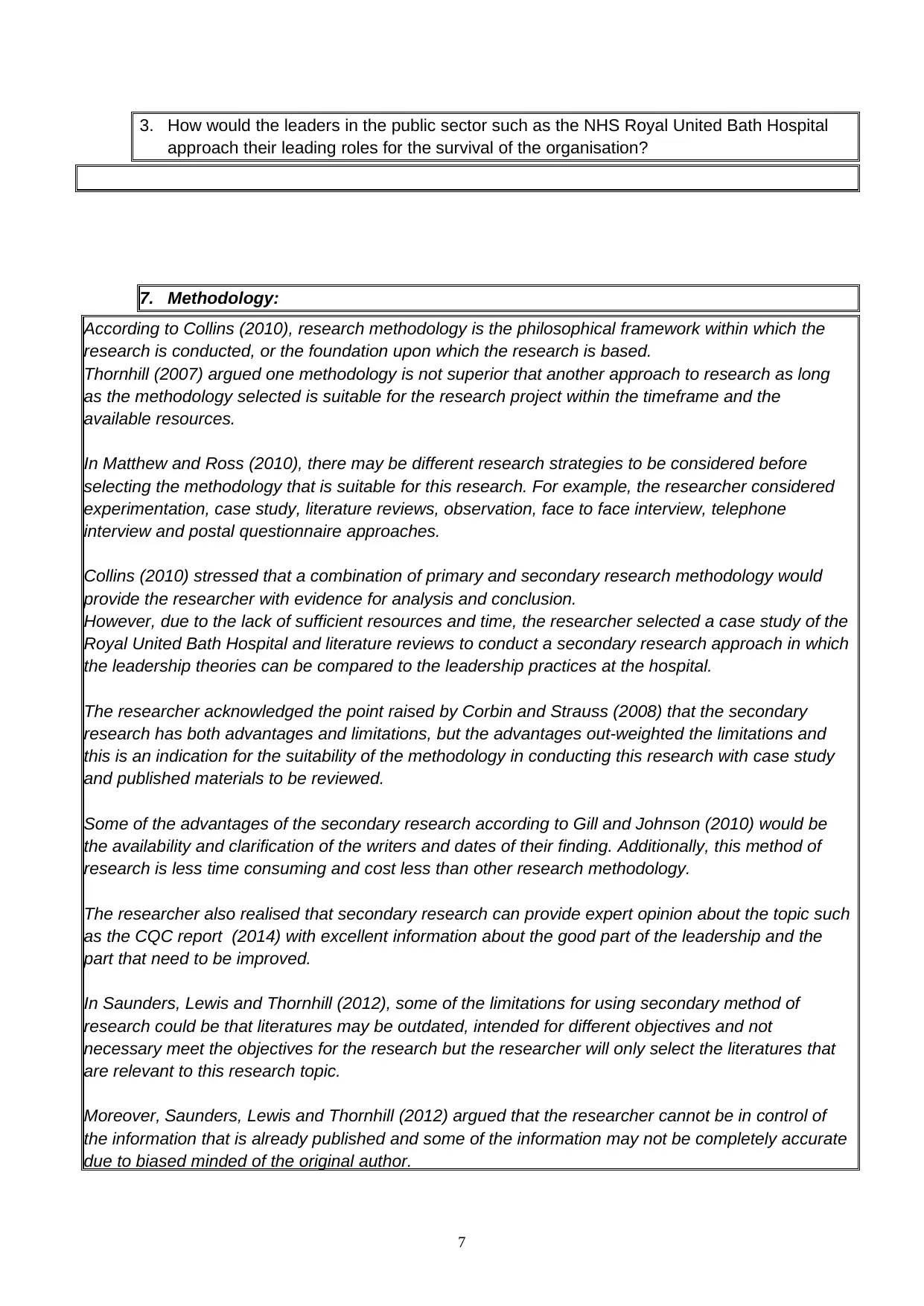
3. How would the leaders in the public sector such as the NHS Royal United Bath Hospital
approach their leading roles for the survival of the organisation?
7. Methodology:
According to Collins (2010), research methodology is the philosophical framework within which the
research is conducted, or the foundation upon which the research is based.
Thornhill (2007) argued one methodology is not superior that another approach to research as long
as the methodology selected is suitable for the research project within the timeframe and the
available resources.
In Matthew and Ross (2010), there may be different research strategies to be considered before
selecting the methodology that is suitable for this research. For example, the researcher considered
experimentation, case study, literature reviews, observation, face to face interview, telephone
interview and postal questionnaire approaches.
Collins (2010) stressed that a combination of primary and secondary research methodology would
provide the researcher with evidence for analysis and conclusion.
However, due to the lack of sufficient resources and time, the researcher selected a case study of the
Royal United Bath Hospital and literature reviews to conduct a secondary research approach in which
the leadership theories can be compared to the leadership practices at the hospital.
The researcher acknowledged the point raised by Corbin and Strauss (2008) that the secondary
research has both advantages and limitations, but the advantages out-weighted the limitations and
this is an indication for the suitability of the methodology in conducting this research with case study
and published materials to be reviewed.
Some of the advantages of the secondary research according to Gill and Johnson (2010) would be
the availability and clarification of the writers and dates of their finding. Additionally, this method of
research is less time consuming and cost less than other research methodology.
The researcher also realised that secondary research can provide expert opinion about the topic such
as the CQC report (2014) with excellent information about the good part of the leadership and the
part that need to be improved.
In Saunders, Lewis and Thornhill (2012), some of the limitations for using secondary method of
research could be that literatures may be outdated, intended for different objectives and not
necessary meet the objectives for the research but the researcher will only select the literatures that
are relevant to this research topic.
Moreover, Saunders, Lewis and Thornhill (2012) argued that the researcher cannot be in control of
the information that is already published and some of the information may not be completely accurate
due to biased minded of the original author.
7
approach their leading roles for the survival of the organisation?
7. Methodology:
According to Collins (2010), research methodology is the philosophical framework within which the
research is conducted, or the foundation upon which the research is based.
Thornhill (2007) argued one methodology is not superior that another approach to research as long
as the methodology selected is suitable for the research project within the timeframe and the
available resources.
In Matthew and Ross (2010), there may be different research strategies to be considered before
selecting the methodology that is suitable for this research. For example, the researcher considered
experimentation, case study, literature reviews, observation, face to face interview, telephone
interview and postal questionnaire approaches.
Collins (2010) stressed that a combination of primary and secondary research methodology would
provide the researcher with evidence for analysis and conclusion.
However, due to the lack of sufficient resources and time, the researcher selected a case study of the
Royal United Bath Hospital and literature reviews to conduct a secondary research approach in which
the leadership theories can be compared to the leadership practices at the hospital.
The researcher acknowledged the point raised by Corbin and Strauss (2008) that the secondary
research has both advantages and limitations, but the advantages out-weighted the limitations and
this is an indication for the suitability of the methodology in conducting this research with case study
and published materials to be reviewed.
Some of the advantages of the secondary research according to Gill and Johnson (2010) would be
the availability and clarification of the writers and dates of their finding. Additionally, this method of
research is less time consuming and cost less than other research methodology.
The researcher also realised that secondary research can provide expert opinion about the topic such
as the CQC report (2014) with excellent information about the good part of the leadership and the
part that need to be improved.
In Saunders, Lewis and Thornhill (2012), some of the limitations for using secondary method of
research could be that literatures may be outdated, intended for different objectives and not
necessary meet the objectives for the research but the researcher will only select the literatures that
are relevant to this research topic.
Moreover, Saunders, Lewis and Thornhill (2012) argued that the researcher cannot be in control of
the information that is already published and some of the information may not be completely accurate
due to biased minded of the original author.
7
Paraphrase This Document
Need a fresh take? Get an instant paraphrase of this document with our AI Paraphraser
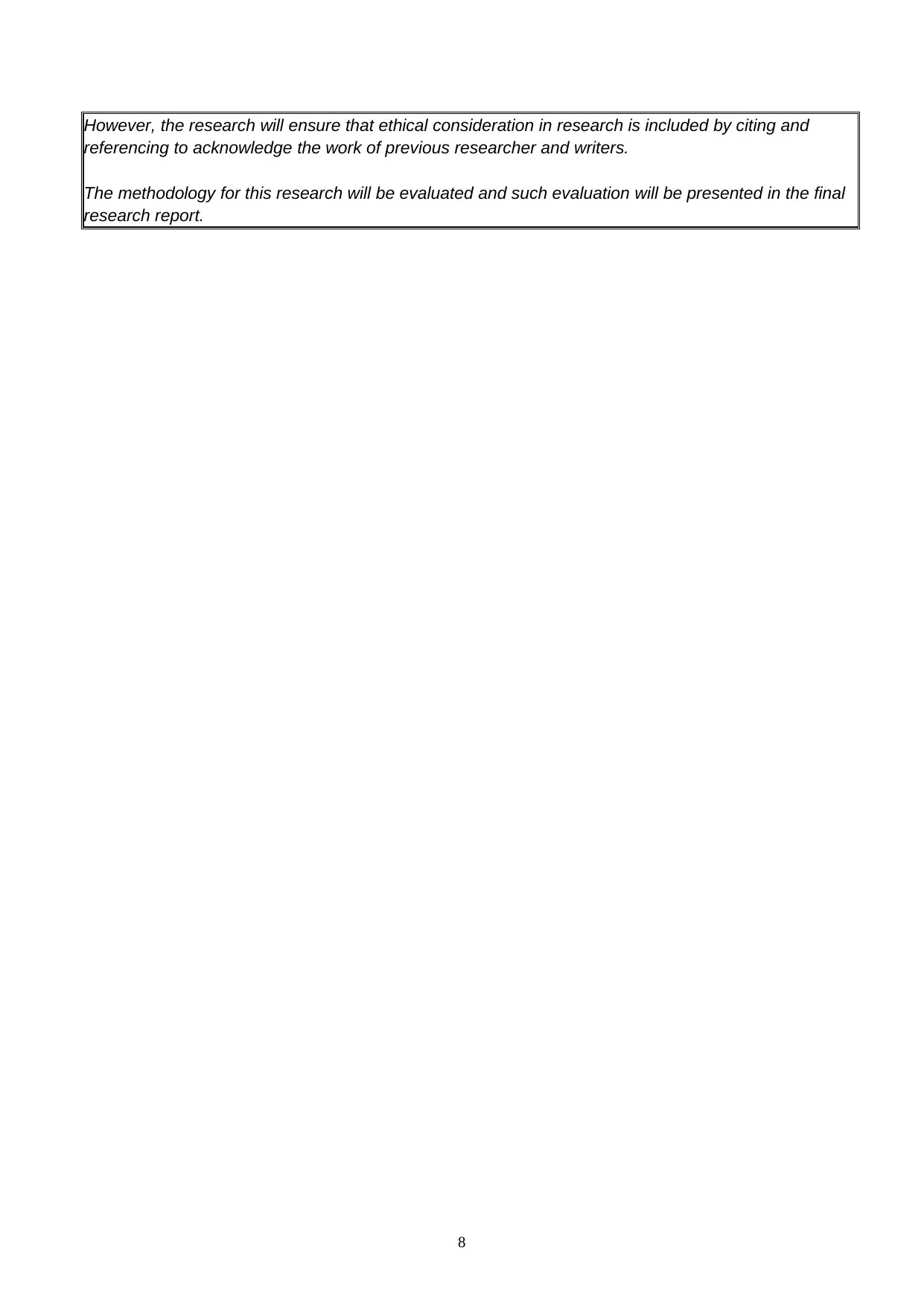
However, the research will ensure that ethical consideration in research is included by citing and
referencing to acknowledge the work of previous researcher and writers.
The methodology for this research will be evaluated and such evaluation will be presented in the final
research report.
8
referencing to acknowledge the work of previous researcher and writers.
The methodology for this research will be evaluated and such evaluation will be presented in the final
research report.
8
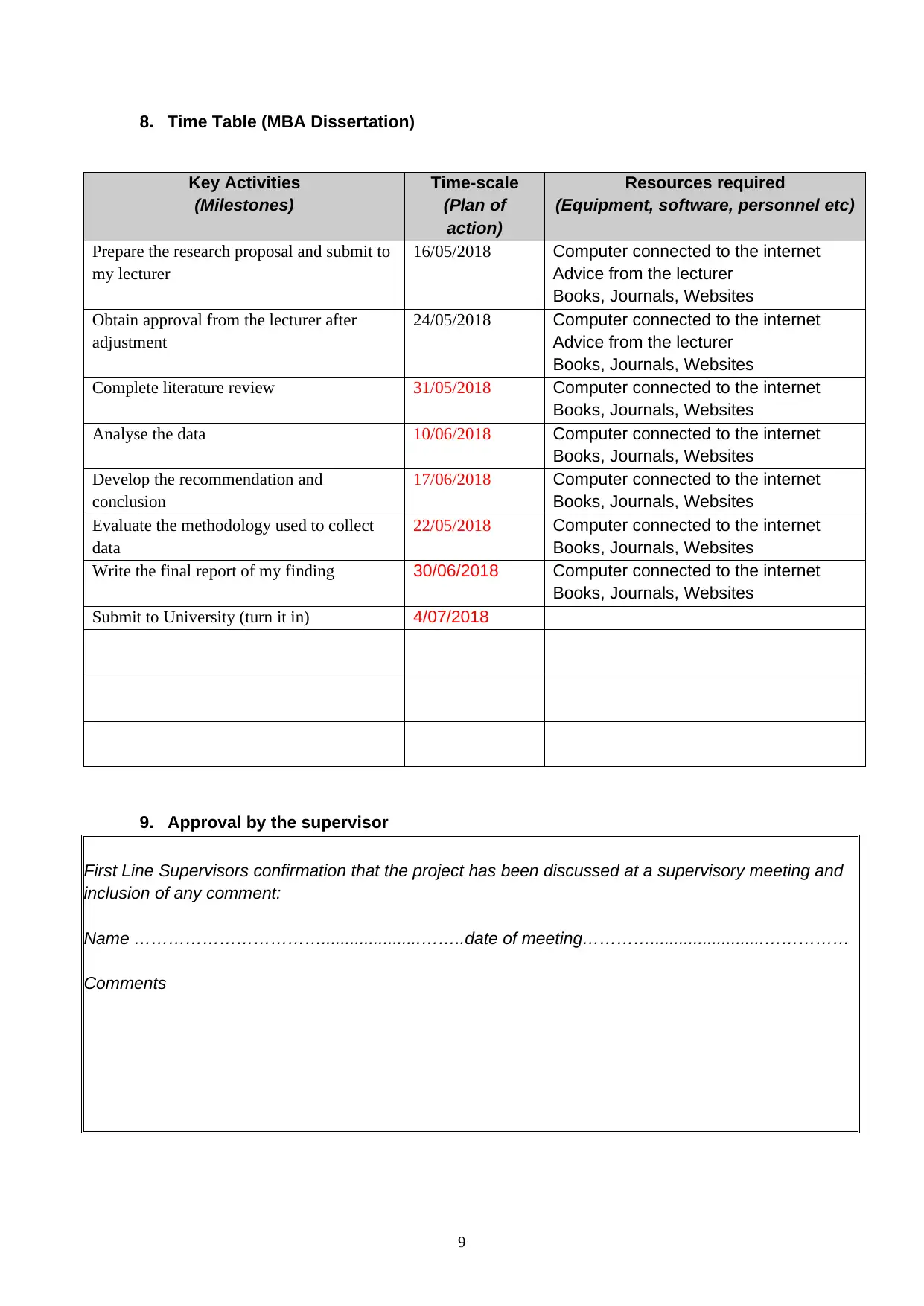
8. Time Table (MBA Dissertation)
Key Activities
(Milestones)
Time-scale
(Plan of
action)
Resources required
(Equipment, software, personnel etc)
Prepare the research proposal and submit to
my lecturer
16/05/2018 Computer connected to the internet
Advice from the lecturer
Books, Journals, Websites
Obtain approval from the lecturer after
adjustment
24/05/2018 Computer connected to the internet
Advice from the lecturer
Books, Journals, Websites
Complete literature review 31/05/2018 Computer connected to the internet
Books, Journals, Websites
Analyse the data 10/06/2018 Computer connected to the internet
Books, Journals, Websites
Develop the recommendation and
conclusion
17/06/2018 Computer connected to the internet
Books, Journals, Websites
Evaluate the methodology used to collect
data
22/05/2018 Computer connected to the internet
Books, Journals, Websites
Write the final report of my finding 30/06/2018 Computer connected to the internet
Books, Journals, Websites
Submit to University (turn it in) 4/07/2018
9. Approval by the supervisor
First Line Supervisors confirmation that the project has been discussed at a supervisory meeting and
inclusion of any comment:
Name …………………………….....................……..date of meeting…………........................……………
Comments
9
Key Activities
(Milestones)
Time-scale
(Plan of
action)
Resources required
(Equipment, software, personnel etc)
Prepare the research proposal and submit to
my lecturer
16/05/2018 Computer connected to the internet
Advice from the lecturer
Books, Journals, Websites
Obtain approval from the lecturer after
adjustment
24/05/2018 Computer connected to the internet
Advice from the lecturer
Books, Journals, Websites
Complete literature review 31/05/2018 Computer connected to the internet
Books, Journals, Websites
Analyse the data 10/06/2018 Computer connected to the internet
Books, Journals, Websites
Develop the recommendation and
conclusion
17/06/2018 Computer connected to the internet
Books, Journals, Websites
Evaluate the methodology used to collect
data
22/05/2018 Computer connected to the internet
Books, Journals, Websites
Write the final report of my finding 30/06/2018 Computer connected to the internet
Books, Journals, Websites
Submit to University (turn it in) 4/07/2018
9. Approval by the supervisor
First Line Supervisors confirmation that the project has been discussed at a supervisory meeting and
inclusion of any comment:
Name …………………………….....................……..date of meeting…………........................……………
Comments
9
⊘ This is a preview!⊘
Do you want full access?
Subscribe today to unlock all pages.

Trusted by 1+ million students worldwide
1 out of 9
Related Documents
Your All-in-One AI-Powered Toolkit for Academic Success.
+13062052269
info@desklib.com
Available 24*7 on WhatsApp / Email
![[object Object]](/_next/static/media/star-bottom.7253800d.svg)
Unlock your academic potential
Copyright © 2020–2025 A2Z Services. All Rights Reserved. Developed and managed by ZUCOL.





